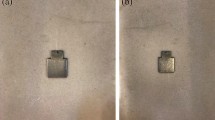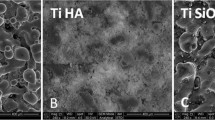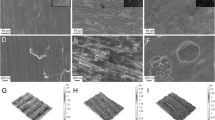Abstract
The prime objectives in the development of biomaterials for dental applications are to improve the quality of osseointegration and to short the time needed to achieve it. Design of implants nowadays involves changes in the surface characteristics to obtain a good cellular response. Incorporating osteoinductive elements is one way to achieve the best regeneration possible post-implantation. This study examined the osteointegrative potential of two distinct biomaterials: sandblasted acid-etched titanium and a silica sol–gel hybrid coating, 70% MTMOS-30% TEOS. In vitro, in vivo, and proteomic characterisations of the two materials were conducted. Enhanced expression levels of ALP and IL-6 in the MC3T3-E1 cells cultured with coated discs, suggest that growing cells on such surfaces may increase mineralisation levels. 70M30T-coated implants showed improved bone growth in vivo compared to uncoated titanium. Complete osseointegration was achieved on both. However, coated implants displayed osteoinductive properties, while uncoated implants demonstrated osteoconductive characteristics. Coagulation-related proteins attached predominantly to SAE-Ti surface. Surface properties of the material might drive the regenerative process of the affected tissue. Analysis of the proteins on the coated dental implant showed that few proteins specifically attached to its surface, possibly indicating that its osteoinductive properties depend on the silicon delivery from the implant.
Graphical abstract







Similar content being viewed by others
References
Khan WS, Rayan F, Dhinsa BS, Marsh D (2012) An osteoconductive, osteoinductive, and osteogenic tissue-engineered product for trauma and orthopaedic surgery: how far are we? Stem Cells Int. Article ID 236231, 7. https://doi.org/10.1155/2012/236231
Charyeva O, Altynbekov K, Zhartybaev R, Sabdanaliev A (2012) Long-term dental implant success and survival–a clinical study after an observation period up to 6 years. Swed Dent J 36:1–6
Le Guéhennec L, Soueidan A, Layrolle P, Amouriq Y (2007) Surface treatments of titanium dental implants for rapid osseointegration. Dent Mater 23:844–854. https://doi.org/10.1016/j.dental.2006.06.025
Solheim E (1998) Osteoinduction by demineralised bone. Int Orthop 22:335–342. https://doi.org/10.1007/s002640050273
Wilson-Hench J (1987) Osteoinduction. In: Williams DF (ed) Progress in biomedical engineering, Defin Biomater, vol 4. Elsevier, p 29
Carlsson L, Röstlund T, Albrektsson B et al (1986) Osseointegration of titanium implants. Acta Orthop Scand 57:285–289. https://doi.org/10.3109/17453678608994393
Eckert SE, Koka S (2006) Osseointegrated dental implants. In: Johnson FE, Virgo KS, Lairmore TC, Audisio RA (eds) The bionic human, Humana Press. https://doi.org/10.1007/978-1-59259-975-2_45
Buser D, Broggini N, Wieland M et al (2004) Enhanced bone apposition to a chemically modified SLA titanium surface. J Dent Res 83:529–533. https://doi.org/10.1177/154405910408300704
Martinez-Ibañez M, Juan-Diaz MJ, Lara-Saez I et al (2016) Biological characterization of a new silicon based coating developed for dental implants. J Mater Sci Mater Med 27:80. https://doi.org/10.1007/s10856-016-5690-9
Romero-Gavilán F, Barros-Silva S, García-Cañadas J et al (2016) Control of the degradation of silica sol-gel hybrid coatings for metal implants prepared by the triple combination of alkoxysilanes. J Non Cryst Solids 453:66–73. https://doi.org/10.1016/j.jnoncrysol.2016.09.026
Reffitt DM, Ogston N, Jugdaohsingh R et al (2003) Orthosilicic acid stimulates collagen type 1 synthesis and osteoblastic differentiation in human osteoblast-like cells in vitro. Bone 32:127–135. https://doi.org/10.1016/S8756-3282(02)00950-X
Ha SW, Neale Weitzmann M, Beck GR (2014) Bioactive silica nanoparticles promote osteoblast differentiation through stimulation of autophagy and direct association with LC3 and p62. ACS Nano 8:5898–5910. https://doi.org/10.1021/nn5009879
Schmidt DR, Waldeck H, Kao WJ (2009) Protein adsorption to biomaterials. In: Puleo DA, Bizios R (eds) Biological interactions on materials surfaces: understanding and controlling protein, cell, and tissue, Springer. https://doi.org/10.1007/978-0-387-98161-1
Chen Z, Klein T, Murray RZ et al (2015) Osteoimmunomodulation for the development of advanced bone biomaterials. Mater Today 19:304–321. https://doi.org/10.1016/j.mattod.2015.11.004
Calciolari E, Donos N (2018) The use of omics profiling to improve outcomes of bone regeneration and osseointegration. How far are we from personalized medicine in dentistry? J Proteomics. https://doi.org/10.1016/j.jprot.2018.01.017
Romero-Gavilán F, Gomes NC, Ródenas J et al (2017) Proteome analysis of human serum proteins adsorbed onto different titanium surfaces used in dental implants. Biofouling 33:98–111. https://doi.org/10.1080/08927014.2016.1259414
Ajai S, Sabir A (2013) Evaluation of serum alkaline phosphatase as a biomarker of healing process progression of simple diaphyseal fractures in adult patients. Int Res J Biol Sci Int Res J Biol Sci 2:2278–3202
Li Y, Bäckesjö C-M, Haldosén L-A, Lindgren U (2008) IL-6 receptor expression and IL-6 effects change during osteoblast differentiation. Cytokine 43:165–173. https://doi.org/10.1016/j.cyto.2008.05.007
Huang W, Yang S, Shao J, Li Y-P (2007) Signaling and transcriptional regulation in osteoblast commitment and differentiation. Front Biosci 12:3068–3092. https://doi.org/10.2741/2296
Al-maawi S, Orlowska A, Sader R et al (2017) In vivo cellular reactions to different biomaterials—physiological and pathological aspects and their consequences. Semin Immunol 29:49–61. https://doi.org/10.1016/j.smim.2017.06.001
Hirsh SL, McKenzie DR, Nosworthy NJ et al (2013) The Vroman effect: competitive protein exchange with dynamic multilayer protein aggregates. Colloids Surf B Biointerfaces 103:395–404. https://doi.org/10.1016/j.colsurfb.2012.10.039
Falgarone G, Chiocchia G (2009) Clusterin: a multifacet protein at the crossroad of inflammation and autoimmunity. Adv Cancer Res 104:139–170. https://doi.org/10.1016/S0065-230X(09)04008-1
Cho NH, Seong SY (2009) Apolipoproteins inhibit the innate immunity activated by necrotic cells or bacterial endotoxin. Immunology 128:479–486. https://doi.org/10.1111/j.1365-2567.2008.03002.x
Loi F, Córdova LA, Pajarinen J et al (2016) Inflammation, fracture and bone repair. Bone 86:119–130. https://doi.org/10.1016/j.bone.2016.02.020
Chu AJ (2010) Blood coagulation as an intrinsic pathway for proinflammation: a mini review. Inflamm Allergy Drug Targets 9:32–44. https://doi.org/10.2174/187152810791292890
Wehner C, Janjić K, Agis H (2017) Relevance of the plasminogen system in physiology, pathology, and regeneration of oral tissues—from the perspective of dental specialties. Arch Oral Biol 74:136–145. https://doi.org/10.1016/j.archoralbio.2016.09.014
Wakabayashi S, Koide T (2011) Histidine-rich glycoprotein: a possible modulator of coagulation and fibrinolysis. Semin Thromb Hemost 37:389–394. https://doi.org/10.1055/s-0031-1276588
Kolte D, Shariat-Madar Z (2016) Plasma Kallikrein inhibitors in cardiovascular disease an innovative therapeutic approach. Cardiol Rev 24:99–109. https://doi.org/10.1097/CRD.0000000000000069
Schmaier AH, McCrae KR (2007) The plasma kallikrein-kinin system: its evolution from contact activation. J Thromb Haemost 5:2323–2329. https://doi.org/10.1111/j.1538-7836.2007.02770.x
Niemeier A, Schinke T, Heeren J, Amling M (2012) The role of apolipoprotein E in bone metabolism. Bone 50:518–524. https://doi.org/10.1016/j.bone.2011.07.015
Rivera-Chacon DM, Alvarado-Velez M, Acevedo-Morantes CY et al (2013) Fibronectin and vitronectin promote human fetal osteoblast cell attachment and proliferation on nanoporous titanium surfaces. J Biomed Nanotechnol 9:1092–1097. https://doi.org/10.1166/jbn.2013.1601
Ru D-W, Yan Y-F, Li B et al (2016) Tetranectin knock-out mice exhibit features of kyphosis and osteoporosis. Fudan Univ J Med Sci 43:159. https://doi.org/10.3969/j.issn.1672-8467.2016.02.006
Albrektsson T, Johansson C (2001) Osteoinduction, osteoconduction and osseointegration. Eur Spine J 10:96–101. https://doi.org/10.1007/s005860100282
Martínez-Ibáñez M, Murthy NS, Mao Y et al (2017) Enhancement of plasma protein adsorption and osteogenesis of hMSCs by functionalized siloxane coatings for titanium implants. J Biomed Mater Res Part B Appl Biomater 106:1138–1147. https://doi.org/10.1002/jbm.b.33889
Acknowledgements
This work was supported by MAT2017-86043-R (MINECO); Universidad Jaume I under UJI-B2017-37 and Grant Predoc/2014/25; University of the Basque Country (UPV/EHU) through UFI11/56; Basque Government through IT611-13 and Grant Predoc/2016/1/0141, and Generalitat Valenciana under Grant Grisolia/2014/016. Authors would like to thank Antonio Coso and Jaime Franco (GMI-Ilerimplant) for their inestimable contribution to this study, and Raquel Oliver, José Ortega (UJI) and Iraide Escobes (CIC bioGUNE) for their valuable technical assistance.
Author information
Authors and Affiliations
Corresponding author
Rights and permissions
About this article
Cite this article
Araújo-Gomes, N., Romero-Gavilán, F., García-Arnáez, I. et al. Osseointegration mechanisms: a proteomic approach. J Biol Inorg Chem 23, 459–470 (2018). https://doi.org/10.1007/s00775-018-1553-9
Received:
Accepted:
Published:
Issue Date:
DOI: https://doi.org/10.1007/s00775-018-1553-9




